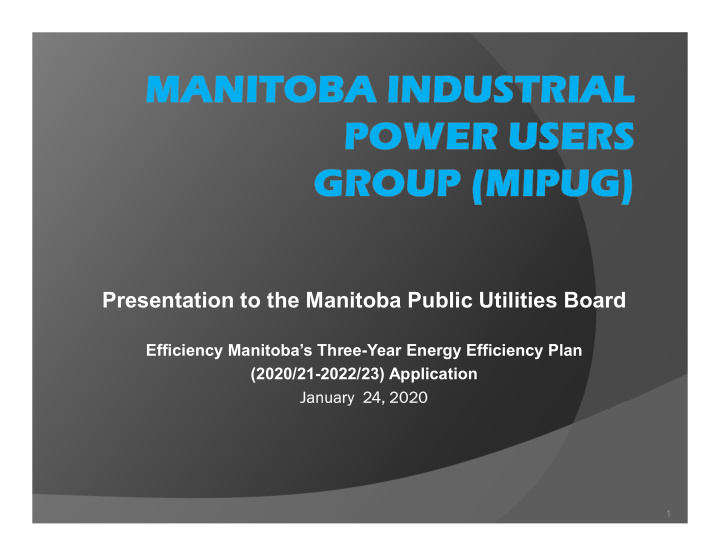



Presentation to the Manitoba Public Utilities Board Efficiency Manitoba’s Three-Year Energy Efficiency Plan (2020/21-2022/23) Application January 24, 2020 1
MIPUG Members Basic Chemicals: Manufacturing: Chemtrade Logistics (previously Gerdau Long Steel North America Canexus Chemicals) (Brandon); (Selkirk); ERCO Worldwide (Virden); Amsted Rail - Griffin Wheel Company (Winnipeg); Koch Fertilizer Canada ULC (Brandon); Winpak Ltd. (Winnipeg); Pulp & Paper: Integra Castings (CTD Group) (Winkler); Canadian Kraft Paper Inc. (previously Pipeline: Tolko Industries - The Pas); Enbridge Pipelines Inc. (Southern Mb.); Agribusiness/Food TC Energy Keystone Pipeline (Southern Production: MB). Hylife Ltd. (Neepawa); Maple Leaf Foods Inc. (Brandon); Roquette (Portage la Prairie) 2
Introduction MIPUG is an association of 13 major industrial companies belonging to the three General Service Large rate classes Core focus relates to electricity rates and supply in Manitoba, lesser focus on natural gas due to nature processes and availability of natural gas (i.e. rural Manitoba) Consume slightly more than half of all energy used by industrial sector within Manitoba Represents interests of GSL customers specifically and industrial sector broadly Regularly communicates with other industries/industry groups, such as Canadian Manufacturers & Exporters (CME) Participated in every Hydro rate proceeding since the late 1980s (including Major Capital Project Review, Centra Gas Acquisition and NFAT) 3
Priorities of MIPUG Members Reliable, economically sustainable power supply: Substantive use of energy is accompanied by significant employment and economic activity that contributes strongly to a vibrant and prosperous Manitoba economy ; Stable, predictable and necessary changes to rates that are fairly distributed across classes (i.e. cost-based); Energy efficiency program opportunities that can provide economic benefits to our members without disproportionately impacting those unable to participate: Efforts that focus on the competitiveness of industry in Manitoba and prioritize investments that support efficient, productive and sustainable enterprises. MIPUG is concerned about the short-term rate impacts of the EM Plan, which is the first of several such three-year plans. 4
MIPUG Direct MB Economic Impact Employee salaries and benefits >$350 Million for >6,200 full time jobs Contract employment >$75 Million for 1,300 jobs Provincial Taxes >$225 Million Capital Investment in Manitoba >$6.5 Billion total Contribution to Provincial GDP Nearly $3 Billion Electricity Purchases Approximately $185 million/year (2019) 5
Operating in Manitoba Energy Usage Energy intensive facilities: 10% to 50+% of production costs Inability to pass on costs to end users (price takers, contracts) Indirect impact upon operating costs resulting from local supplier cost increases which do get passed through Disadvantages Long distances to markets with limited transportation options Energy price escalation at rates exceeding most other competitive regions in North America Current lack of load management and self-generation options Our Competition comes from across the continent and our markets are mostly outside Manitoba 6
Efficiency Manitoba Mandate The initial Three-Year Plan filed by EM represents the start of a 15- year mandate with aggressive targets for electricity and natural gas savings that are not linked to a demonstrated need; The mandated targets are the most aggressive proposed in Manitoba’s nearly 30-year history of engagement in energy conservation and come after significant savings opportunities have already been captured by prior Manitoba Hydro efforts; Funding for EM expenditures will be provided by Manitoba Hydro, so achievement of the targets will ultimately impact energy rates in Manitoba; Industrial participation in the Plan is expected to provide a significant portion of the mandated savings target for the Plan up to 40% of electric and 30% of natural gas savings, but at only 20% and 9% of targeted program spending. 7
MIPUG Efficiency Participation Members want to play a key role in achieving the target savings; Financially justifiable efficiency projects that serve to reduce manufacturing costs and offset corresponding Manitoba Hydro rate impacts are of key priority; Implementation of energy efficiency projects by our Members is a complex undertaking: Current Efficiency levels versus Best Available Technology vary widely across the industrial sector (i.e. not everyone has the same opportunity). Capital Investment needed to support these Efficiency projects competes extensively with other priorities in each company. Timelines for implementation are by necessity generally encumbered by business conditions and timing of facility maintenance outages, which for some members can be up to five (5) years apart. Large capital investments required for projects can exceed the incentive capital available from Efficiency Manitoba. 8
Program Success The overall cost-effectiveness of the Efficiency Manitoba portfolio will be highly dependent on engagement of the industrial sector and the MIPUG members that dominate energy consumption; Achievement of the Plan requires direct investment of $60 - $75 million by the industrial sector, about $30 - $35 million by MIPUG members. Successful Implementation for the benefit of all impacted Stakeholders will require: Targeted savings levels should be based on Manitoba’s energy needs to minimize cost impacts. Selective portfolio implementation to maximize benefits at the lowest cost benefits all ratepayers. Encourage flexibility in target program spending between rate classes to achieve optimal and cost-efficient outcomes with minimal rate impacts. Overall program targets that balance Efficiency of Consumption with Competitive Manitoba Hydro rates to ensure long term viability of our valuable manufacturers & exporters. 9
Recommend
More recommend